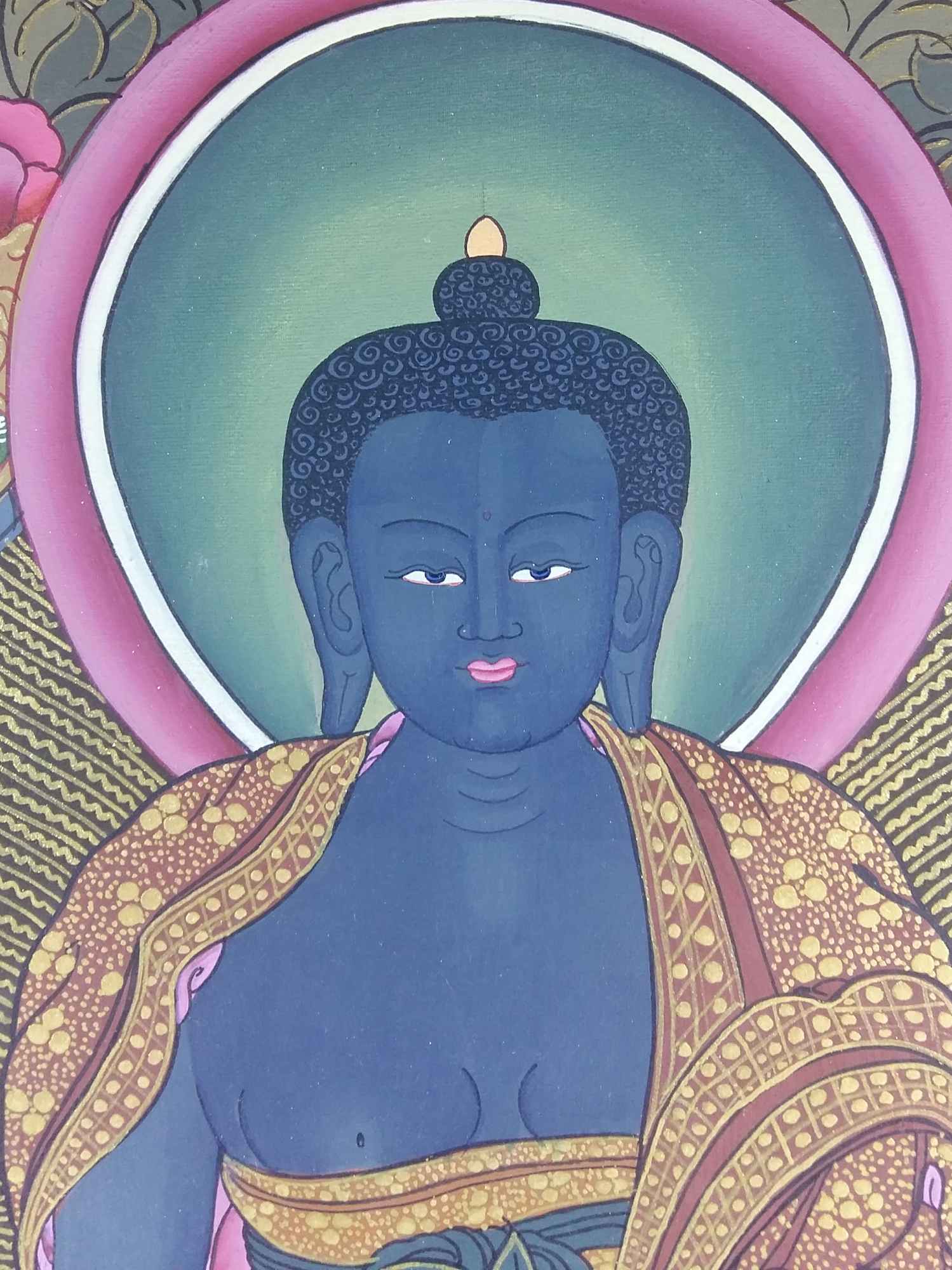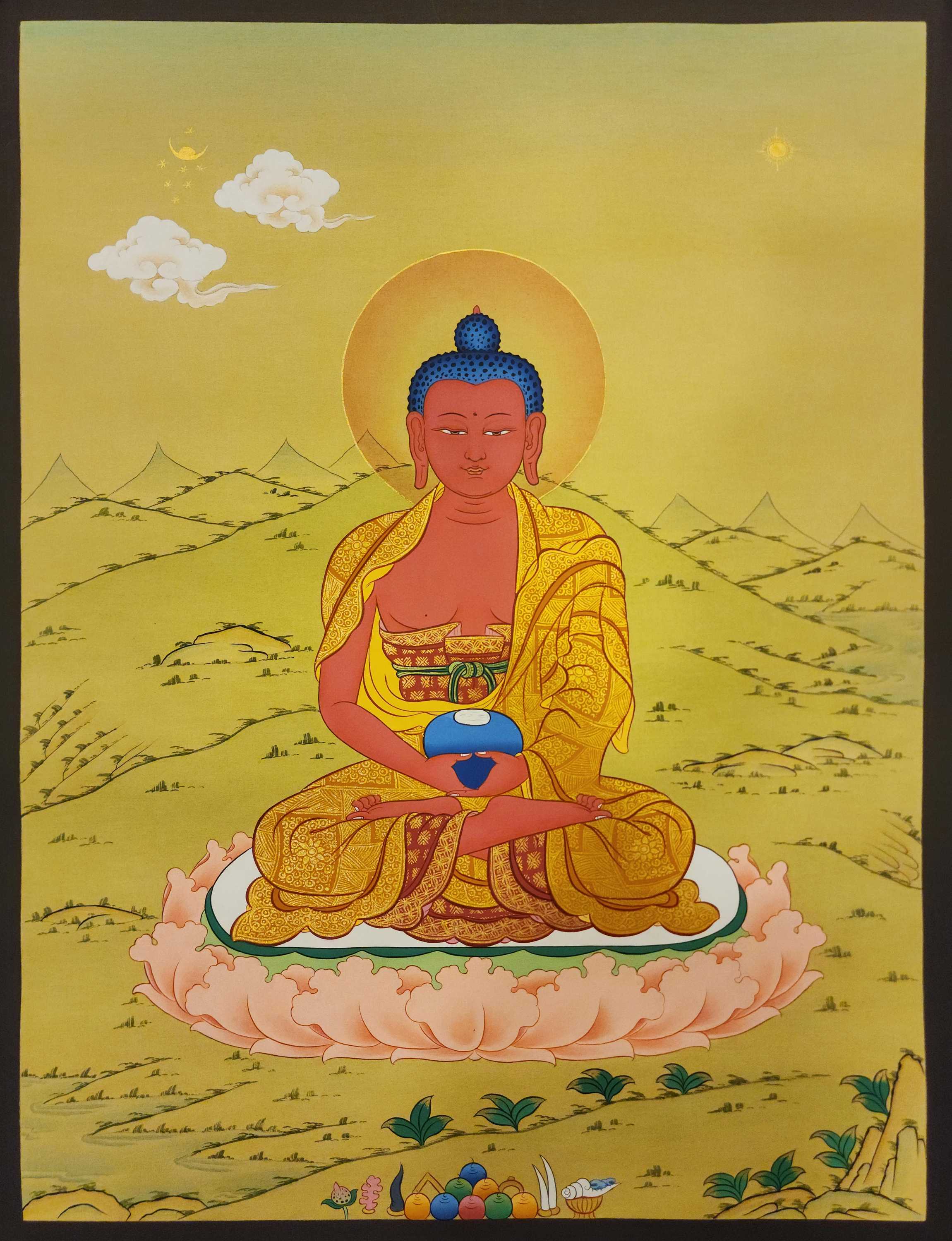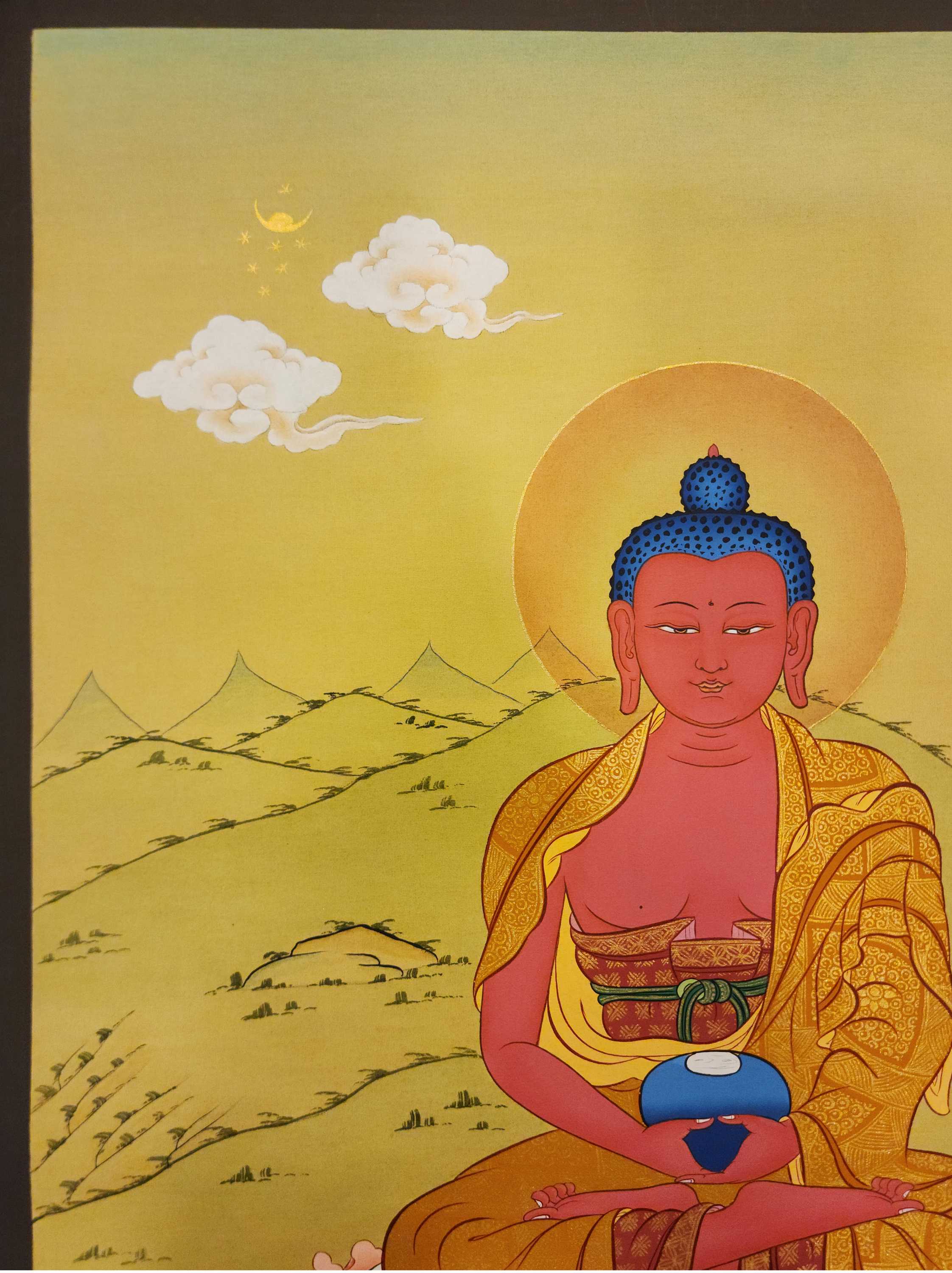Code
HCS29659
Weight
400 gm / 0.88 lbs
Size
Height
77cm (30") Width
55cm (22") Material
Cotton Canvas & Natural Color
Availability
Available

Safe Payment
We accept Paypal, Money Transfer, Bank Transfer
Confidence
Protection covers your purchase and personal data.
Worldwide Delivery
We ship Worldwide, except Russia.Shipping cost US$25.2 for upto 0.5 kgs

Hotline
Talk to help line for your question on 9841267335Master Quality : What is master Quality?
The attribute of "master quality" distinguishes the Akshobhya Buddha Thangka, [mater Quality], Buddhist Painting, Newari Style, With [24k Gold] as an embodiment of extraordinary craftsmanship and artistic excellence. This exceptional piece is directly handcrafted by an artist or craftsman of the highest categorization, reflecting their unparalleled skill and expertise. The uniqueness of Akshobhya Buddha Thangka, [mater Quality], Buddhist Painting, Newari Style, With [24k Gold] lies in its exclusivity to the artist, making it a rare find with nearly impossible chances of finding an identical piece in the same category. While copies may exist, they can never truly replicate the essence of the original, as an artist or craftsman capable of creating such exceptional artistry would prefer to showcase their own creative vision rather than reproduce another's work. Read More . . .
The attribute of "master quality" distinguishes the Akshobhya Buddha Thangka, [mater Quality], Buddhist Painting, Newari Style, With [24k Gold] as an embodiment of extraordinary craftsmanship and artistic excellence. This exceptional piece is directly handcrafted by an artist or craftsman of the highest categorization, reflecting their unparalleled skill and expertise. The uniqueness of Akshobhya Buddha Thangka, [mater Quality], Buddhist Painting, Newari Style, With [24k Gold] lies in its exclusivity to the artist, making it a rare find with nearly impossible chances of finding an identical piece in the same category. While copies may exist, they can never truly replicate the essence of the original, as an artist or craftsman capable of creating such exceptional artistry would prefer to showcase their own creative vision rather than reproduce another's work. Read More . . .
Use of Real Gold
This thangka of Akshobhya Buddha Thangka, [mater Quality], Buddhist Painting, Newari Style, With [24k Gold] has real gold painted on its surface along with other paints. This is an ancient process of decorating the thangka in Tibetan Buddhism, Here gold is ground into gold dust, which is then mixed with other undisclosed material to make it paintable on the canvas. this mixture is then mixed with transparent glue and painted on the thangka. Read More . . .
This thangka of Akshobhya Buddha Thangka, [mater Quality], Buddhist Painting, Newari Style, With [24k Gold] has real gold painted on its surface along with other paints. This is an ancient process of decorating the thangka in Tibetan Buddhism, Here gold is ground into gold dust, which is then mixed with other undisclosed material to make it paintable on the canvas. this mixture is then mixed with transparent glue and painted on the thangka. Read More . . .
Newari Paubha
This Akshobhya Buddha Thangka, [mater Quality], Buddhist Painting, Newari Style, With [24k Gold] is a newari thangka or Paubaha, Paubha, also known as "paubhas," is a traditional religious painting created by the Newar people of Nepal. These exquisite artworks depict various subjects, including deities, mandalas, and monuments, and serve as aids for meditation and spiritual practices. Paubhas are similar to Tibetan Thangka paintings and are highly regarded for their religious and cultural significance.
While most paubhas portray Buddhist subjects, there are also a few that incorporate Hindu themes. The creation of these paintings is seen as a means of earning religious merit for both the artist and the patron. Newar Buddhists often commission skilled artists, primarily from the Chitrakar caste (known as Pun in Nepal Bhasa), to paint paubhas that are displayed during festivals and special occasions. Read More . . .
This Akshobhya Buddha Thangka, [mater Quality], Buddhist Painting, Newari Style, With [24k Gold] is a newari thangka or Paubaha, Paubha, also known as "paubhas," is a traditional religious painting created by the Newar people of Nepal. These exquisite artworks depict various subjects, including deities, mandalas, and monuments, and serve as aids for meditation and spiritual practices. Paubhas are similar to Tibetan Thangka paintings and are highly regarded for their religious and cultural significance.
While most paubhas portray Buddhist subjects, there are also a few that incorporate Hindu themes. The creation of these paintings is seen as a means of earning religious merit for both the artist and the patron. Newar Buddhists often commission skilled artists, primarily from the Chitrakar caste (known as Pun in Nepal Bhasa), to paint paubhas that are displayed during festivals and special occasions. Read More . . .
Introduction to Thangka
A thangka, also known as tangka, thanka, or tanka, is a vibrant and intricate Tibetan Buddhist painting that serves as a visual representation of spiritual teachings. Crafted with meticulous detail on cotton or silk appliqué, thangkas depict a wide range of subjects including Buddhist deities, sacred scenes, mandalas, and narrative stories. These sacred artworks are traditionally kept unframed and rolled up for storage, resembling ancient scrolls. To protect their delicate nature, thangkas are mounted on textile backings and often adorned with a silk cover on the front. Proper preservation in dry environments is crucial to maintain the integrity and longevity of the silk. Read More . . .
A thangka, also known as tangka, thanka, or tanka, is a vibrant and intricate Tibetan Buddhist painting that serves as a visual representation of spiritual teachings. Crafted with meticulous detail on cotton or silk appliqué, thangkas depict a wide range of subjects including Buddhist deities, sacred scenes, mandalas, and narrative stories. These sacred artworks are traditionally kept unframed and rolled up for storage, resembling ancient scrolls. To protect their delicate nature, thangkas are mounted on textile backings and often adorned with a silk cover on the front. Proper preservation in dry environments is crucial to maintain the integrity and longevity of the silk. Read More . . .
Iconography :
Akshobhya Buddha, known as the Unshakable One, is one of the Five Dhyani Buddhas in Tibetan Buddhist tradition. He represents the cosmic element of consciousness and embodies qualities such as fearlessness, patience, and transformation. Akshobhya is revered as a symbol of steadfastness and is associated with the purification of negative emotions and the attainment of enlightenment. Devotion to Akshobhya Buddha plays a significant role in Tibetan Buddhist practice.
Iconography:
Akshobhya Buddha is often depicted as a radiant blue figure, representing the unchanging nature of the awakened mind. He is seated in the vajra posture, with his right hand touching the earth in the Bhumisparsha Mudra, symbolizing his enlightenment and calling the earth his witness. His left-hand rests in the meditation mudra, holding a vajra, a symbol of spiritual power and enlightenment.
History:
Akshobhya Buddha's origins can be traced back to ancient Buddhist texts and teachings. His significance grew within the Vajrayana tradition of Tibet, where he became an important figure associated with transformation and the purification of negative emotions. Akshobhya's practice and teachings became integrated into the rich tapestry of Tibetan Buddhist philosophy and meditation practices.
Temples and Monasteries:
While there might not be specific temples dedicated solely to Akshobhya Buddha in Nepal, there are monasteries and centers around the world that honor this deity. Some notable examples include the Borobudur Temple in Indonesia, which houses a significant Akshobhya statue, and the Shingon Buddhist temples in Japan, where Akshobhya is revered as one of the central deities.
Benefits of Practicing Akshobhya:
The devotion and practice of Akshobhya Buddha offer various benefits to practitioners. By cultivating qualities such as patience, fearlessness, and equanimity, individuals can transform negative emotions, purify karma, and develop a deeper sense of inner stability and peace. Akshobhya's practice is also believed to be helpful in overcoming anger, aggression, and attachments, leading to the attainment of enlightenment.
How to Practice:
To practice Akshobhya Buddha, individuals can engage in meditation, recitation of mantras, visualization, and contemplation on the qualities and teachings associated with this deity. Following the guidance of a qualified teacher or lama is recommended to deepen one's understanding and experience of Akshobhya's transformative practice.
Mantras of Akshobhya Buddha:
The primary mantra associated with Akshobhya is:
"Om Akshobhya Hum"
Reciting this mantra during meditation or as part of a dedicated practice can invoke the qualities and blessings of Akshobhya Buddha, aiding in the purification of negative emotions and the cultivation of wisdom and fearlessness.
Akshobhya Buddha is often depicted as a radiant blue figure, representing the unchanging nature of the awakened mind. He is seated in the vajra posture, with his right hand touching the earth in the Bhumisparsha Mudra, symbolizing his enlightenment and calling the earth his witness. His left-hand rests in the meditation mudra, holding a vajra, a symbol of spiritual power and enlightenment.
History:
Akshobhya Buddha's origins can be traced back to ancient Buddhist texts and teachings. His significance grew within the Vajrayana tradition of Tibet, where he became an important figure associated with transformation and the purification of negative emotions. Akshobhya's practice and teachings became integrated into the rich tapestry of Tibetan Buddhist philosophy and meditation practices.
Temples and Monasteries:
While there might not be specific temples dedicated solely to Akshobhya Buddha in Nepal, there are monasteries and centers around the world that honor this deity. Some notable examples include the Borobudur Temple in Indonesia, which houses a significant Akshobhya statue, and the Shingon Buddhist temples in Japan, where Akshobhya is revered as one of the central deities.
Benefits of Practicing Akshobhya:
The devotion and practice of Akshobhya Buddha offer various benefits to practitioners. By cultivating qualities such as patience, fearlessness, and equanimity, individuals can transform negative emotions, purify karma, and develop a deeper sense of inner stability and peace. Akshobhya's practice is also believed to be helpful in overcoming anger, aggression, and attachments, leading to the attainment of enlightenment.
How to Practice:
To practice Akshobhya Buddha, individuals can engage in meditation, recitation of mantras, visualization, and contemplation on the qualities and teachings associated with this deity. Following the guidance of a qualified teacher or lama is recommended to deepen one's understanding and experience of Akshobhya's transformative practice.
Mantras of Akshobhya Buddha:
The primary mantra associated with Akshobhya is:
"Om Akshobhya Hum"
Reciting this mantra during meditation or as part of a dedicated practice can invoke the qualities and blessings of Akshobhya Buddha, aiding in the purification of negative emotions and the cultivation of wisdom and fearlessness.


![Akshobhya Buddha Thangka, [mater Quality], Buddhist Painting, Newari Style, With [24k Gold]](https://handicraftseller.com/uploads/pics/product/thumb/2023/06/29659_1.jpg)
![Akshobhya Buddha Thangka, [mater Quality], Buddhist Painting, Newari Style, With [24k Gold]](https://handicraftseller.com/uploads/pics/product/thumb/2023/06/29659_2.jpg)
![Akshobhya Buddha Thangka, [mater Quality], Buddhist Painting, Newari Style, With [24k Gold]](https://handicraftseller.com/uploads/pics/product/thumb/2023/06/29659_3.jpg)
![Akshobhya Buddha Thangka, [mater Quality], Buddhist Painting, Newari Style, With [24k Gold]](https://handicraftseller.com/uploads/pics/product/thumb/2023/06/29659_4.jpg)
![Akshobhya Buddha Thangka, [mater Quality], Buddhist Painting, Newari Style, With [24k Gold]](https://handicraftseller.com/uploads/pics/product/thumb/2023/06/29659_5.jpg)
![Akshobhya Buddha Thangka, [mater Quality], Buddhist Painting, Newari Style, With [24k Gold]](https://handicraftseller.com/uploads/pics/product/thumb/2023/06/29659.jpg)
![Akshobhya Buddha Thangka, [mater Quality], Buddhist Painting, Newari Style, With [24k Gold]](https://handicraftseller.com/uploads/pics/product/thumb/2023/06/29659_0.jpg)










 of Medicine Buddha" title="Tibetan Thangka
of Medicine Buddha" title="Tibetan Thangka  of Medicine Buddha" title="Tibetan Thangka
of Medicine Buddha" title="Tibetan Thangka  with Manjushri
with Manjushri  with Manjushri
with Manjushri  of Shakyamuni Buddha,
of Shakyamuni Buddha,  of Shakyamuni Buddha,
of Shakyamuni Buddha,  Master Quality, Buddhist Traditional Painting, Tibetan Style,
Master Quality, Buddhist Traditional Painting, Tibetan Style,  Master Quality, Buddhist Traditional Painting, Tibetan Style,
Master Quality, Buddhist Traditional Painting, Tibetan Style,  of Maha Vairochana" title="Tiny Thangka
of Maha Vairochana" title="Tiny Thangka  of Shakyamuni Buddha,
of Shakyamuni Buddha,  of Shakyamuni Buddha,
of Shakyamuni Buddha, 

 of Shakyamuni Buddha
of Shakyamuni Buddha  of Shakyamuni Buddha
of Shakyamuni Buddha  Real Gold, Sariputra
Real Gold, Sariputra  Real Gold, Sariputra
Real Gold, Sariputra  of Shakyamuni Buddha" title="Tibetan Thangka
of Shakyamuni Buddha" title="Tibetan Thangka  of Shakyamuni Buddha" title="Tibetan Thangka
of Shakyamuni Buddha" title="Tibetan Thangka